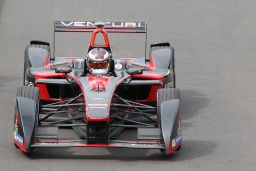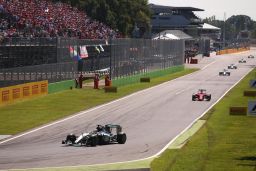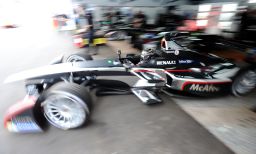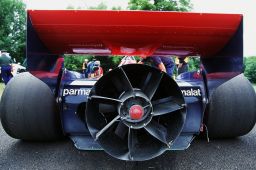Story highlights
Formula E is the newest series from motorsport's governing body the FIA
The global racing series highlights electric car technology
The budget for a season in Formula E is capped at $3.5m
It’s the new kid on the motorsport grid with a point to prove – accelerating the development and interest in battery-powered cars.
Formula E, the world’s first fully electric racing series, might not make as much noise or be as fast – yet – as their more illustrious petrol-powered cousins in Formula One, but the new series, currently in its second season, is inspiring a new generation of motorsport fans.
So how do the two compare in terms of speed, rules and drama? Read on to get the inside track.
RACING ON A BUDGET
F1 cars are million-dollar dream machines.
Each team spends a small fortune interpreting the technical regulations set out by motorsport’s governing body, the FIA.
If you get it right, like Mercedes which has married a dominant engine with a sleek aerodynamic chassis and star driver Lewis Hamilton, then a team can eclipse the competition.
In Formula E, the rules, the competition and the purse strings, are much tighter.
A season in F1 is estimated to cost at least $44m – and that’s for the smallest teams – while the budget for Formula E is officially capped at $3.5m.
Each Formula E team uses the same battery and chassis design but in Season Two they have the freedom to develop their engines around the e-motor, inverter and gearboxes.
“Formula E has opened the technical regulations in a fair way,” Renault e-dams racer Sebastien Buemi told CNN.
“The rules are opening slowly. Today, it’s the rear motor and the suspension but the power coming out of the battery is the same for everyone, so it’s difficult to make a huge gap in performance between the teams.”
ELECTRIC FEEL
Electric racers hum rather than roar like F1’s engines – OK, we know they’re not as loud as they used to be but …
Despite the difference in decibels, Buemi reveals the sensation behind the wheel of an electric racer is surprisingly similar to its noisy F1 relations.

“People love to know what the differences are with an electric car but it does feel like driving a normal single-seater,” explains Buemi, who raced for three seasons in F1 with Toro Rosso and is still reserve driver for Red Bull Racing.
“There is more weight with the battery at the back of the car so this makes the car slide a little bit more but it doesn’t feel completely different to drive.
“There are gears, brakes, a throttle pedal; I’m sure in the near future the only big difference will be the noise.”
THE NEED FOR SPEED
There is no denying that Formula E cars have less grunt than F1’s machines when it comes to pure pace.
F1 world champion Hamilton clocked 225 mph (362 kph) at the Mexico Grand Prix weekend – his top speed last season – but how does that compare to the electric racers?
“Formula E circuits are a lot shorter than F1 tracks so the only place we are able to compare is Monaco because both Formula E and F1 race there,” says Buemi. “Although Formula E doesn’t use the exact same track as the Monaco Grand Prix.
“We know the top speed in a city center ePrix is around 134-137 mph (215-220 kph) and F1 cars reach 174 mph (280 kph) in Monaco. So F1 is still a bit quicker.
“But we are just at the start of electric car racing and I’m sure we will get closer to (the speeds) F1 is doing.”
FOUR SESSIONS IN ONE DAY
F1 grand prix are run over three days with practice and qualifying on Fridays and Saturdays and the race showdown on Sunday.
Formula E, however, completes two practice sessions (of 45 and 30 minutes), qualifying and race all on one day – a Saturday – with the ePrix always starting at 4pm local time.
“The fact that everything happens on one day is a good thing,” enthuses Buemi. “You see a lot of racing and it’s a full day.
“When you pay for your ticket it’s also a lot less expensive than F1.”
The Swiss racer is on the money. A single day ticket at the last ePrix in Punta de Este, Uruguay cost between $18 and $93.
In comparison, general adult admission to the 2016 F1 season-opener in Australia begins at $150 for four days and rises to $3,800.
F1’s more leisurely pace over three days, however, means its teams and drivers have time to finesse their cars and race strategies. They pull out all the stops to provide world-class entertainment on Sunday’s race day.
Formula E’s fast and furious pace arguably lends itself to more unpredictability.
“Formula E is a guessing game,” says commentator Jack Nicholls. “Before a race you go and speak to the team managers and they say ‘we don’t know what our race pace will be.’
“There’s not enough time to gather the data so it makes for some very exciting racing. F1 is chess at 200 mph whereas Formula E is dodgems at 100 mph.”
RACING IN THE STREETS

Iconic motorsport meccas such as Monza in Italy, Britain’s Silverstone and Belgium’s Spa track routinely host F1 races but these long, high-speed tracks are not suitable for racers relying on battery power.
Instead, Formula E goes racing in the streets in the heart of major global cities from Beijing to London.
The shorter street circuits also showcase electric cars in an urban setting and bring racing closer to the fans.
“If you live in the city you don’t have to travel at all,” says Buemi. “It’s easy to access the pit lane, the paddock and to nearly touch the cars.”
Nicholls, who also commentates on F1, compares this experience to the historic formula: “To go to an F1 race you have to make a pilgrimage, you have to drive or get the bus or train 60 miles out of a capital city.
“It’s amazing to be in the city center with Formula E. Racing around the Kremlin in Moscow was unbelievable and really added to the atmosphere of the race weekend.
“The result is you get a varied audience, some people who clearly know what’s going on and love it and some people who are new to motorsport.”
THE PERFECT 10?
F1 is poised for a record-breaking 21 grands prix in 2016 while the electric championship makes 10 stops on its world tour this season.
Formula E has already added new ePrix in Paris and Mexico in Season Two and there are ambitious plans for future races in Australia and Africa.
“We want to expand but 21 races is too much,” says Formula E CEO Alejandro Agag. “Maybe 16 or 18 as the tops.”
RULES AND REWARDS

Pit stops in Formula E are about swapping cars rather than tires.
Each car is charged with 30 minutes of battery power and so the drivers must make a mandatory swap for a fully-charged spare car during the ePrix which lasts around 50 minutes. Teams are not allowed to charge up their cars during the race or qualifying.
In F1, the drivers must stop to change tires but in that formula the cars run on slick tires whereas Formula E cars use 18-inch Michelin tires with treads which are suitable for both wet and dry conditions.
The same number of points are handed out in F1 and Formula E, with a victory bagging the driver and team 25 points down to 10th place which is worth one point.
Formula E also adds a twist by handing out three extra points for pole position and two points for clocking the fastest lap during the race.
FAN POWER

The concept of fan power in F1 brings back memories of Brabham’s 1978 racer, which brilliantly stuck to the track with the help of a giant fan on its tail.
But in Formula E fan power asks the sport’s devotees to vote and give their favorite driver’s car a 100kJ surge of energy during the race, which can be used in the “power window.”
Online voting begins 12 days before each ePrix on the championship’s website and on social media using hashtags.
In Season Two, voting stays open six minutes into the race, and there’s already been an 800% increase in voters over the first two races.
F1’s famous fan car was once described a vacuum cleaner on wheels but in Formula E fan power is more like “X-Factor” on wheels.
AFTER PARTY
There is an important tradition that Formula E has borrowed from big brother F1 – the after race party.
In fact you could argue the whole weekend is one big party, with an EJ spinning tunes throughout the ePrix.
“The fun element is absolutely key to Formula E,” says Nicholls. “There is always a big party after the race and that makes it feel like a place you want to be.”















